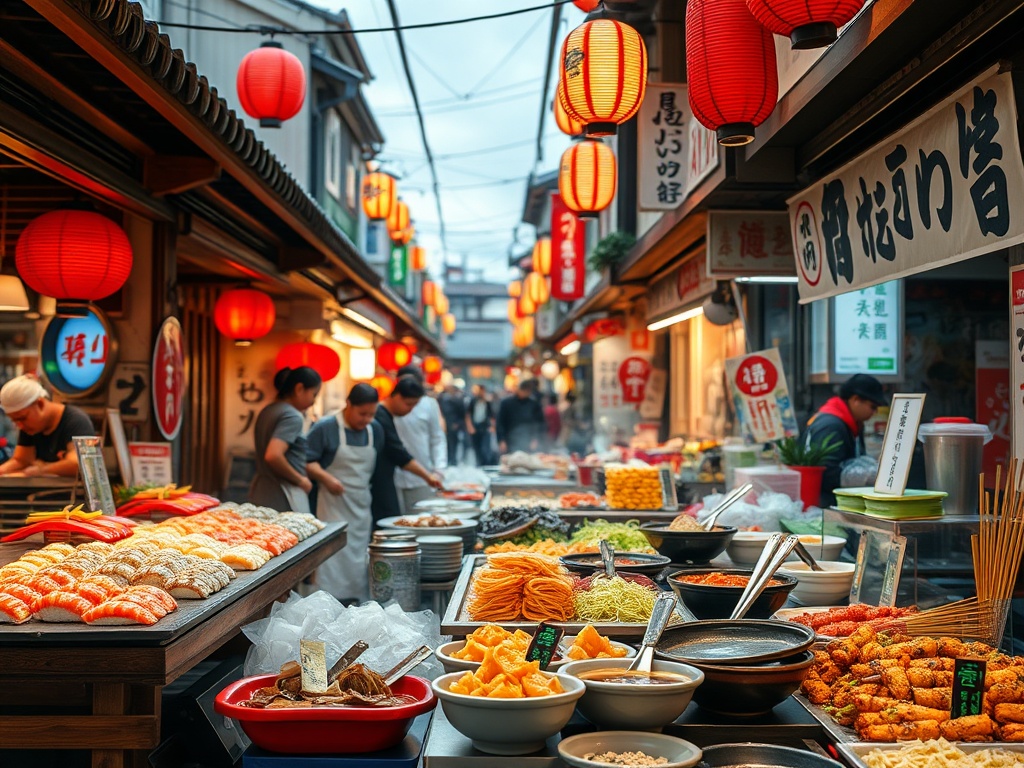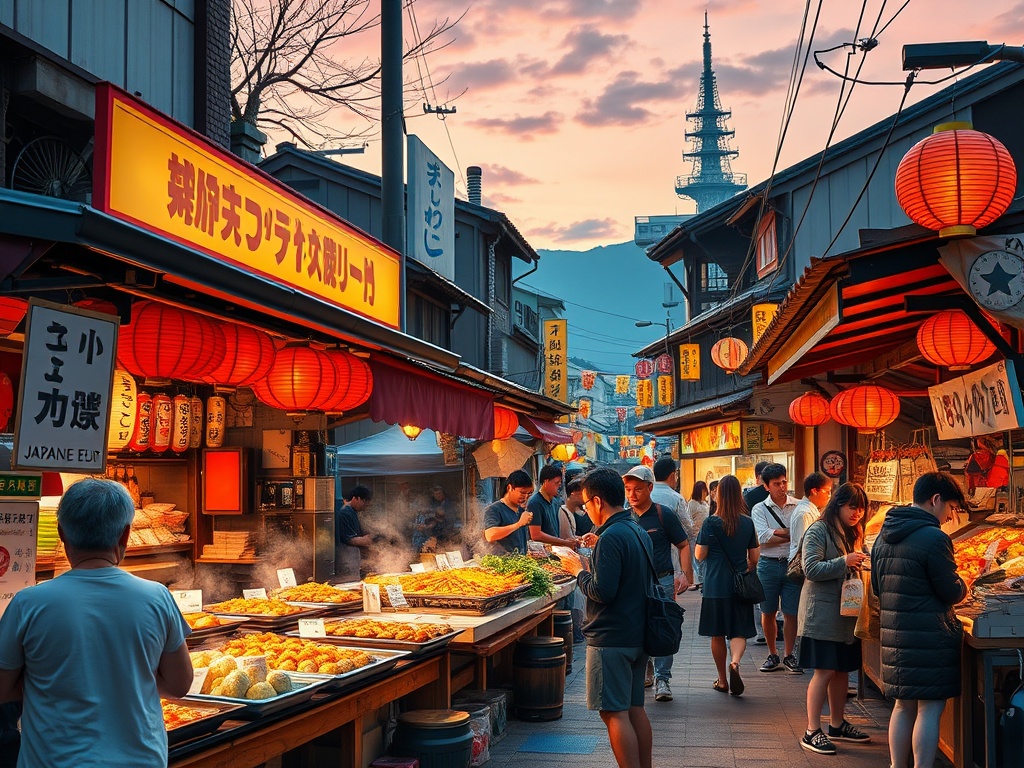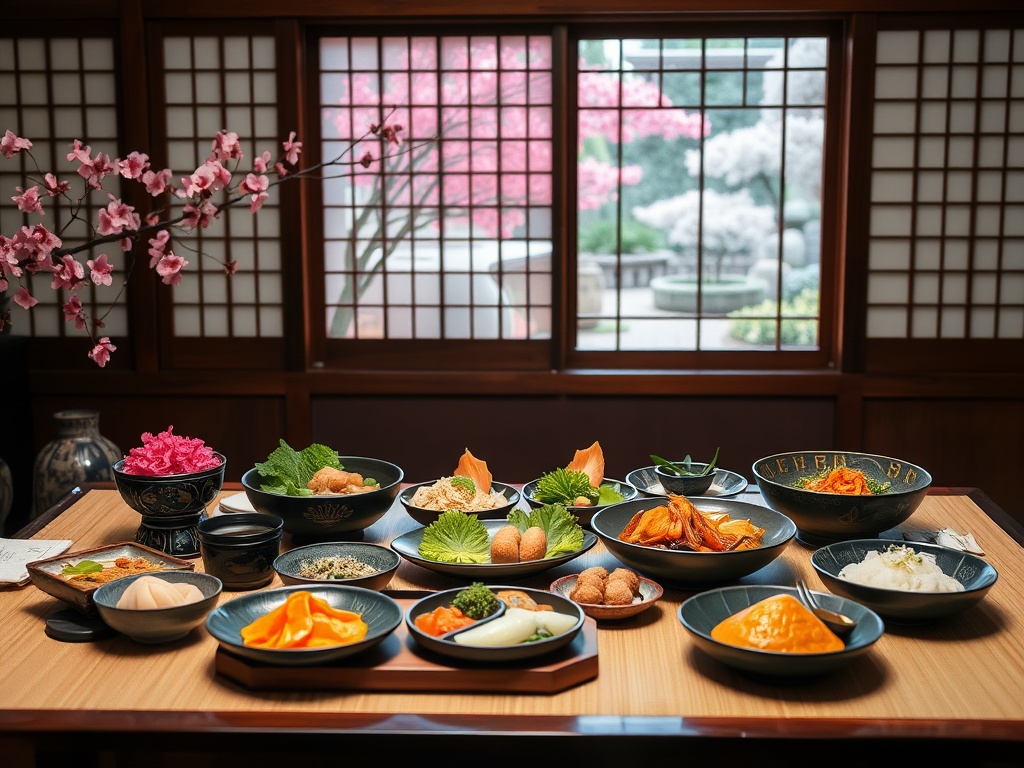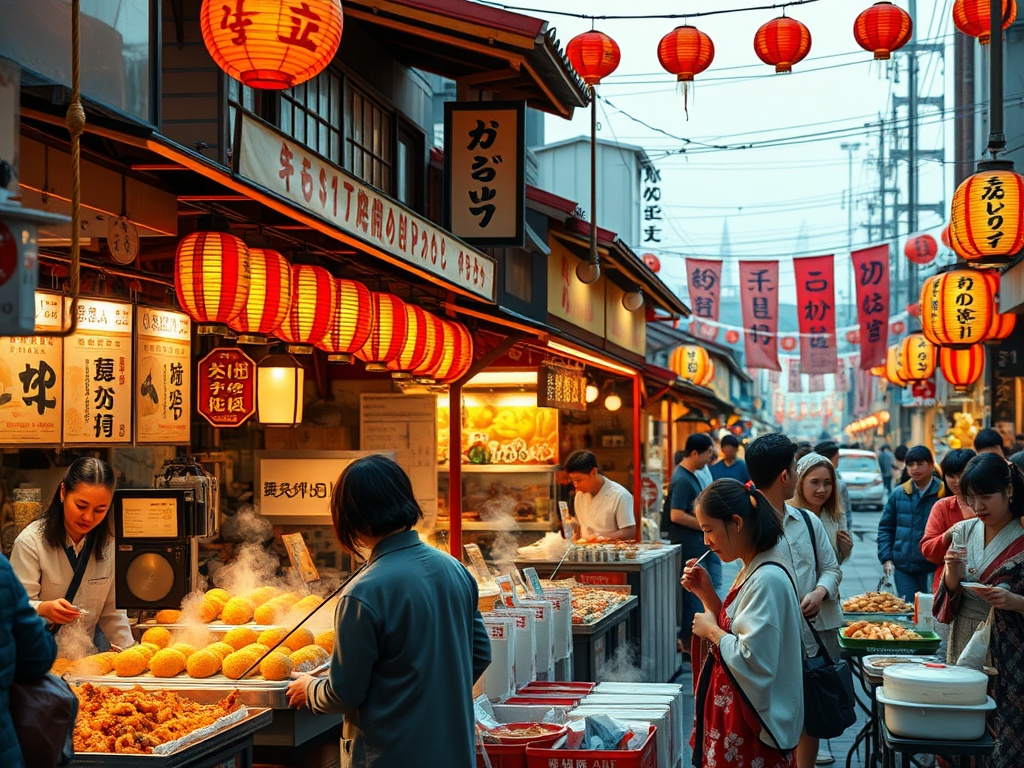Beyond Sushi: Unraveling Japan’s Culinary Secrets
Win a Free Trip to Japan!
Experience cherry blossoms and ancient temples
When most people think of Japanese cuisine, sushi often steals the spotlight. But in the heart of Japan, there lies a vibrant tapestry of flavors waiting to be discovered by the intrepid traveler. Beyond the well-trodden sushi bars, Japan offers an array of culinary delights that can satisfy even the most adventurous palate. Dive into this culinary journey and uncover the hidden gems that make Japan a true paradise for food enthusiasts.
Japan’s culinary landscape is as diverse as its geography, with each region boasting its own traditional dishes that have been passed down through generations. From the bustling streets of Osaka to the serene landscapes of Hokkaido, a world of flavors awaits.
- Osaka’s Okonomiyaki: Often referred to as the “Japanese pancake,” this savory delight is a must-try. Made with flour, eggs, shredded cabbage, and various toppings like pork or seafood, it’s cooked to perfection on a hot griddle.
- Kyoto’s Kaiseki: Experience the epitome of Japanese haute cuisine with a kaiseki meal. This multi-course dining experience showcases the seasons through meticulously prepared dishes, each a work of art.
- Hokkaido’s Seafood: Known for its fresh seafood, Hokkaido offers uni (sea urchin), kani (crab), and ikura (salmon roe) that are unrivaled in flavor and freshness.
For those who relish the thrill of street food, Japan’s bustling markets and vibrant street stalls offer a feast for the senses. Here, you can indulge in flavors that are both comforting and unexpected.
- Takoyaki: These delightful octopus-filled balls are a staple at festivals. Crispy on the outside and gooey inside, they’re a perfect blend of textures and flavors.
- Yatai Ramen: In Fukuoka, mobile yatai stalls serve steaming bowls of ramen. Each bowl is a symphony of flavors, with rich broth, tender noodles, and a symphony of toppings.
- Imagawayaki: A sweet treat that dates back to the Edo period, these warm, cake-like snacks are filled with sweet red bean paste, custard, or even savory fillings.
Savoring the Seasons: Japan’s Timeless Taste Treasures
As you traverse the culinary landscape of Japan, you’ll quickly realize that the country’s rich heritage is deeply entwined with its seasonal offerings. The Japanese approach to food is not just about nourishment; it’s an artful celebration of nature’s bounty, with each season bringing its own unique flavors and experiences to the table. This tradition of savoring the seasons has been perfected over centuries, offering travelers a chance to engage with the culture on a deeper level through its timeless taste treasures.
Spring in Japan heralds the arrival of sakura (cherry blossoms), and with it comes a selection of dishes that reflect the gentle arrival of warmer days. Spring vegetables, such as bamboo shoots and nanohana (rapeseed blossoms), are celebrated in delicate tempura or simply dressed with a light sauce. Meanwhile, the subtle sweetness of sakura mochi—a pink rice cake with a sweet bean paste filling wrapped in a cherry blossom leaf—captures the essence of this fleeting season.
Summer, on the other hand, is synonymous with vibrant festivals and cooling dishes. The refreshing zaru soba, cold buckwheat noodles served with a savory dipping sauce, is a staple. Unagi (grilled eel) is traditionally enjoyed during the sweltering days of summer believed to provide stamina and vitality. Seasonal fruits like watermelon and mikan (mandarin oranges) offer a sweet reprieve from the heat.
As the leaves turn hues of red and gold, autumn’s rich flavors come to the fore. It’s a time when matsutake mushrooms, prized for their earthy aroma, are sought after in markets and restaurants alike. The season also brings the harvest of kaki (persimmons) and chestnuts, often used in traditional sweets or wagashi to accompany tea ceremonies.
Winter in Japan is a celebration of warmth and comfort, with dishes that bring people together. Nabe, a hot pot dish, becomes a centerpiece at family gatherings, allowing diners to cook and share ingredients such as tofu, vegetables, and thinly sliced meats in a communal pot. The hearty flavors of oden, a winter stew simmered with daikon radish, boiled eggs, and fish cakes, encapsulate the spirit of the season, providing warmth against the chilly air.
Street Food Spectacles: Discovering Japan’s Hidden Flavors
Embark on a culinary expedition through Japan’s bustling streets, where hidden flavors and culinary wonders await the curious traveler. Street food in Japan is not just a meal; it’s an experience—a vibrant mosaic of tastes, aromas, and textures that reveal the soul of Japanese culture. From bustling city markets to quiet alleyway stalls, each bite offers a journey into the heart of Japan’s rich culinary tapestry.
Japanese street food is a treasure trove of delightful surprises, offering a medley of flavors that cater to every taste. As you wander through the lively streets, let your senses guide you to the tantalizing aromas and sizzling sounds of these unique offerings.
- Kushikatsu: This Osaka specialty consists of skewered meats, seafood, and vegetables, deep-fried to golden perfection. Dip them in a savory sauce and experience a burst of flavor with every crunchy bite.
- Korokke: A Japanese twist on the classic croquette, these deep-fried patties are filled with creamy mashed potatoes or minced meat, offering a comforting taste of home.
- Yaki Imo: Follow the aroma of roasted sweet potatoes and you’ll find yaki imo vendors, often selling these warm, caramelized delights from the back of a truck. A simple yet satisfying treat, especially in the cooler months.
Japan’s street food scene truly comes alive in its bustling markets and vibrant night stalls. These lively hubs of culinary activity offer a feast for the senses, where the chatter of vendors, the clinking of cooking utensils, and the irresistible scents of food create an unforgettable atmosphere.
Must-Visit Street Food Markets:
| Market | Location | Specialty |
|---|---|---|
| Nishiki Market | Kyoto | Traditional Japanese snacks and pickles |
| Ameya-Yokocho | Tokyo | Yakitori and seafood skewers |
| Kurokawa Market | Osaka | Okonomiyaki and takoyaki |
Whether you’re savoring a freshly made taiyaki—a fish-shaped cake filled with sweet red bean paste—or indulging in a savory okonomiyaki, Japan’s street food offers a delightful exploration of flavors that reflect the country’s culinary diversity. So, prepare your taste buds for a sensational journey through Japan’s street food spectacles, where every bite is a discovery waiting to be made.
Island of Innovation: Japan’s Avant-Garde Gastronomy
Japan’s culinary scene is not just a celebration of tradition but also a playground for innovation. In the bustling cities and tranquil islands, chefs are redefining Japanese cuisine by blending ancient techniques with modern creativity. This avant-garde gastronomy is a testament to Japan’s spirit of innovation, offering travelers a chance to experience flavors that defy convention yet remain deeply rooted in cultural authenticity.
The fusion of tradition and modernity is where the magic happens in Japan’s culinary arts. Talented chefs take classic dishes and infuse them with unexpected twists, creating an entirely new dining experience. From sushi with non-traditional ingredients to ramen with a fusion twist, these culinary masterpieces surprise and delight the palate.
Innovative Dining Experiences:
- Sushi Reimagined: Discover sushi adorned with exotic toppings like truffle and foie gras, elevating the traditional dish to new heights.
- Ramen with a Twist: Savor ramen bowls featuring unique broths, such as lobster bisque or curry-infused, offering a refreshing take on a beloved staple.
- Tempura Reinvented: Enjoy tempura crafted with unexpected ingredients like avocado and sea urchin, presenting a modern interpretation of this classic fare.
In cities like Tokyo and Kyoto, restaurants act as gastronomic laboratories where culinary boundaries are pushed. Chefs experiment with molecular gastronomy, transforming traditional flavors into visually stunning dishes. These dining establishments are not just places to eat but are immersive experiences that engage all senses.
Must-Try Avant-Garde Restaurants: For those seeking an extraordinary dining experience, Japan’s avant-garde restaurants are a must-visit. Each dish is a masterpiece, offering a glimpse into the future of Japanese cuisine.
Embark on a journey through Japan’s island of innovation, where each meal is an exploration of flavors beyond imagination. Whether you’re sampling reimagined sushi or indulging in a multi-sensory dining experience, Japan’s avant-garde gastronomy promises an unforgettable adventure for the culinary curious.
A Feast for the Senses: Japan’s Regional Delicacies Unveiled
Embark on a tantalizing journey through Japan’s diverse regions, where each locale offers a distinct culinary revelation. Hidden from the mainstream food trails, these regional delicacies are a feast for the senses, promising to captivate your taste buds and leave an indelible mark on your gastronomic map. Prepare to explore flavors that reflect the true essence of Japan’s rich cultural heritage and culinary artistry.
Japan’s culinary diversity is a testament to its unique geography, with each region offering specialties that are deeply intertwined with local culture and traditions. From the snowy mountains of Nagano to the subtropical climate of Okinawa, there’s a rich tapestry of flavors waiting to be explored.
- Nagano’s Soba Noodles: Nestled in the Japanese Alps, Nagano is renowned for its buckwheat soba noodles. Enjoy them served both hot and cold, often with a dipping sauce that enhances their nutty flavor.
- Okinawa’s Goya Champuru: This stir-fried dish, featuring bitter melon, tofu, and pork, is a staple of Okinawan cuisine. It’s a refreshing and healthy option that embodies the island’s vibrant culinary culture.
- Tochigi’s Yuba: Known for its delicate texture, yuba (tofu skin) is a specialty of Tochigi. Often served as a topping on rice or as part of a hot pot, it offers a unique taste experience.
Japan’s regional delicacies are not only about the dishes themselves but also about the local ingredients that make them special. These ingredients are often harvested from the natural bounty of each region, contributing to the distinctive taste and authenticity of the cuisine.
Setouchi Citrus: The Setouchi region is famous for its citrus fruits, especially lemons and oranges, which are used to add a refreshing zest to many local dishes. Whether in desserts or savory meals, their vibrant flavors are a highlight of the region.
Shimane’s Izumo Soba: In Shimane, the Izumo-style soba is a must-try, known for its rich and earthy flavor derived from the use of whole buckwheat grains. Served in a unique three-tiered presentation, it’s a culinary experience that shouldn’t be missed.
Tea Traditions: Exploring Japan’s Art of Brewing
Japan’s culinary allure extends far beyond the realm of food, embracing a rich tapestry of tea traditions that reflect the nation’s cultural depth and historical richness. From the tranquil gardens of Kyoto to the bustling streets of Tokyo, tea is not merely a beverage but a profound experience that captures the essence of Japanese hospitality and harmony. As you venture into Japan’s vibrant tea culture, prepare to immerse yourself in a world where every sip tells a story, and each ceremony unfolds with a graceful elegance.
At the heart of Japan’s tea culture is matcha, a finely ground green tea powder that is celebrated for its vibrant hue and earthy flavor. The preparation of matcha is an art form, deeply rooted in the Zen traditions of mindfulness and simplicity. In a traditional tea ceremony, every movement is deliberate, from the whisking of the tea to the presentation of the cup. This ritual offers a moment of reflection and serenity, inviting participants to appreciate the beauty of the present moment. A visit to a tea house in Kyoto, where matcha is prepared with meticulous care, provides an unforgettable glimpse into this timeless tradition.
Beyond matcha, Japan boasts a myriad of regional teas, each with its unique characteristics and brewing techniques. In Shizuoka, known as the tea capital of Japan, you can savor the delicate flavors of sencha—a steamed green tea that embodies the fresh, grassy notes of spring. Meanwhile, the island of Kyushu offers the robust and smoky taste of hojicha, a roasted green tea that is perfect for a cozy afternoon. These regional teas are often paired with local sweets, creating a harmonious balance that delights the palate and enriches your cultural journey.
As you explore Japan’s tea traditions, don’t miss the opportunity to visit a local tea farm, where you can witness the meticulous process of tea cultivation and harvesting. Engaging with the passionate tea artisans provides a deeper understanding of the dedication and craftsmanship that goes into every cup. Whether you are a seasoned tea connoisseur or a curious traveler, Japan’s tea culture offers a captivating exploration of flavors and traditions that are sure to leave a lasting impression.
Sweet Surprises: Japan’s Delectable Dessert Discoveries
For those with a sweet tooth, Japan offers an enchanting array of desserts that go beyond the conventional, promising to take you on a whimsical culinary journey. From the bustling streets of Tokyo to the serene tea houses of Kyoto, each dessert you encounter is a reflection of Japan’s unique ability to blend artistry and flavor. Prepare to indulge in a world where sweets are not just a treat, but an integral part of the cultural experience, offering a symphony of textures and tastes that will linger in your memory long after your journey has ended.
Japan’s dessert landscape is rich with traditional confections known as wagashi, which are often enjoyed during tea ceremonies and seasonal celebrations. Mochi, a chewy rice cake, is a staple in Japanese dessert culture. Filled with sweet red bean paste or seasonal fruits, each bite offers a delightful contrast of textures. Another must-try is dorayaki, a sweet pancake sandwich filled with anko (sweet red bean paste), offering a perfect balance of sweetness and fluffiness. These traditional sweets not only satisfy your cravings but also provide a taste of Japan’s cultural heritage.
In recent years, Japan has embraced a wave of culinary innovation, blending traditional techniques with modern flavors to create desserts that are as visually stunning as they are delicious. Tokyo’s patisseries are renowned for their exquisite creations, such as matcha-infused pastries and yuzu-flavored chocolates. Meanwhile, the vibrant city of Osaka offers a unique twist on crepes, filled with everything from fresh fruits to cheesecake. These modern delights showcase Japan’s creative spirit and its ability to continually reinvent its culinary traditions.
Whether you’re savoring a delicate wagashi in a tranquil garden or indulging in a fusion dessert in the heart of the city, Japan’s dessert scene is a testament to its rich culinary diversity. Each sweet surprise you discover is a chapter in the story of Japan’s gastronomic artistry, inviting you to explore flavors that are both timeless and innovative.
Umami Unleashed: The Essence of Japanese Flavor
Travelers venturing into Japan’s culinary landscape are often surprised by the profound simplicity and depth that define its flavors. At the heart of this gastronomic wonder lies umami, the fifth taste and the cornerstone of Japanese cuisine. Often described as a savory, deeply satisfying flavor, umami is the elusive element that elevates Japanese dishes to new heights, appealing to those with a penchant for culinary adventures. As you embark on this journey, prepare to delve into the soul of Japanese cooking, where umami reigns supreme and the discovery of each dish brings new layers of flavor to explore.
Central to the umami experience is dashi, a delicate broth that forms the backbone of many Japanese dishes. This simple yet complex stock is typically made from kombu (kelp) and katsuobushi (dried bonito flakes), delivering a potent umami punch that enriches soups, stews, and sauces. Whether you’re enjoying a comforting bowl of miso soup or savoring the intricate flavors of a hot pot, dashi is the invisible thread that ties these culinary experiences together, imparting a depth of flavor that is both subtle and profound.
Fermentation is another secret weapon in Japan’s umami arsenal, with ingredients like miso and soy sauce playing starring roles in the flavor profile of countless dishes. Miso, a fermented soybean paste, is not only the heart of the iconic miso soup but also a versatile ingredient used in marinades, dressings, and glazes. Its rich, savory taste is a testament to the power of fermentation in unlocking umami flavors. Similarly, soy sauce, with its complex, salty-sweet profile, is an indispensable condiment that enhances everything from sushi to grilled meats, adding a burst of umami to every bite.
Embark on a culinary adventure to uncover Japan’s umami-rich delicacies. Here are some must-try foods that showcase the essence of umami:
- Ramen: Dive into a bowl of ramen, where the umami-rich broth is a symphony of flavors, often enhanced with miso or soy sauce.
- Natto: For the adventurous palate, natto—fermented soybeans—offers a unique umami experience with its strong aroma and sticky texture.
- Tsukemono: These pickled vegetables, often served as side dishes, are bursting with umami and provide a refreshing contrast to richer dishes.
As you explore Japan’s hidden culinary gems, let umami guide your taste buds through a world of unparalleled flavor. Each dish offers a new opportunity to savor the essence of Japanese cuisine, where simplicity meets depth, and every bite tells a story of tradition, innovation, and the irresistible allure of umami.



